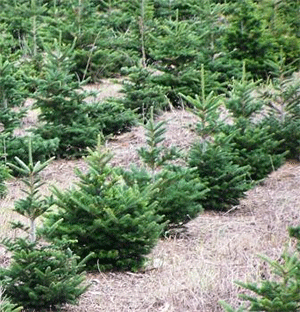By Richard Jauron
Christmas trees and poinsettias are popular, colorful additions to homes during the holiday season. But what happens to them when the holidays are over? Are they thrown to the curb or stuffed in a trash can? They don’t have to be. Here are some great alternative ideas to handle holiday plants following the season.

Iowa State University Extension and Outreach horticulturists can help answer queries regarding reuse and recycling of holiday plants. To have additional questions answered, contact the ISU Hortline at 515-294-3108 or hortline@iastate.edu.
What can I do with the Christmas tree after the holidays?
After the holidays, recycle or dispose of the tree in a responsible manner. Several recycling/disposal options are presented below. (Before recycling the Christmas tree, remove all ornaments, lights and tinsel.)
Place the tree in the yard or garden for use by birds and other wildlife. The branches provide shelter from strong winds and cold. Food can be supplied by hanging fruit slices, seed cakes, suet bags or strings of cranberries or raisins on the tree’s branches. You also can smear peanut butter and seeds in pine cones and hang them in the tree.
Prune off the tree’s branches and place the boughs over perennials as a winter mulch. Chip the tree and use the chipped material as mulch around trees, shrubs or in perennial flower beds.
If you have no use for the tree, contact city officials or your sanitation service. Most communities have some type of Christmas tree disposal program. Some have central collection points, others collect the trees at curbside. Collected trees may be chipped into mulch and made available to local residents or used in city parks. Others may be chipped and composted.
Conservation groups may be another option. Some hunting and fishing groups collect trees and use them to provide habitat for wildlife.
Don’t burn your Christmas tree in a fireplace or wood stove. Dry, evergreen branches literally explode when burned and could cause a house fire.
What should I do with the poinsettia after the holidays?
Most individuals toss the poinsettia when they grow tired of it or it is no longer attractive. However, it is possible to save the poinsettia and force it to flower again next season.
The key to the successful reflowering of the poinsettia is proper care. Cut back the stems to within 4 to 6 inches of the potting soil in March. The poinsettia also may be repotted at this time. When new growth appears, place the poinsettia in a sunny window. Water the plant when the soil surface becomes dry to the touch. Fertilize every two weeks with a dilute fertilizer solution.
In late May, move the poinsettia outdoors. Harden or acclimate the plant to the outdoors by placing it in a shady, protected area for two or three days, then gradually expose it to longer periods of sunlight. The poinsettia should be properly hardened in seven to 10 days. Once hardened, dig a hole in an area that receives six to eight hours of direct sun and set the pot in the ground. To obtain a compact, bushy plant, pinch or cut off the shoot tips once or twice from late June to mid-August. Continue to water and fertilize the plant outdoors.
The poinsettia should be brought indoors in mid-September. Place the plant in a sunny window. The poinsettia is a short-day plant. Short-day plants grow vegetatively during the long days of summer and produce flowers when days become shorter in fall.
To get the poinsettia to flower for Christmas, the plant must receive complete darkness from 5 p.m. to 8 a.m. daily from early October until the bracts develop good color, usually early December. The dark period requirement can be met by placing the plant in a closet or by covering with a box. During the remainder of the day, the poinsettia should be in a sunny window.
Source: iastate.edu